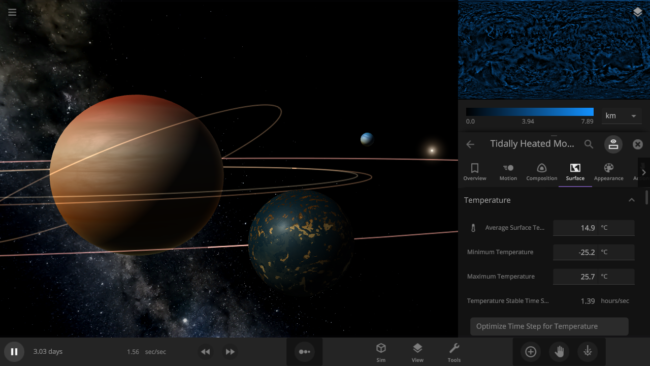Tidal Heating | ScienceLog #2


Simulation in which the Moon orbits way too close to the Earth. Tidal forces from the Earth’s gravity rip fragments from the Moon, tearing it apart.
New and Improved Tidal Heating
Our first ScienceLog explained how the flow of energy into and out of an object is responsible for heating or cooling the object. If you look at the sources of energy in a simulation, listed in the Energy Flow section of the object’s Surface tab, you’ll see Tidal Power listed. Unlike some of the other heat sources, like stars or impacts, tidal heating originates inside the object itself.
Tidal heating has been a part of Universe Sandbox for some time, but after the release of our new Surface Grids feature in Update 24, we noticed that tidal heating wasn’t changing the temperature of planets the way we expected. We traced this unusual behavior back to some errors in our tidal heating calculations, and then we fixed those bugs while we prepared the energy flow tools for Update 25.
Now that we’re more confident in our tidal heating simulation, we thought that for this ScienceLog, we’d dive a little deeper into tidal heating, where it comes from, and how it works in Universe Sandbox. It may not be as flashy as other heating sources, like supernovas or lasers, but tidal heating can create some unexpected and interesting effects, and even determine the habitability of a planet or moon!
What is Tidal Heating?
As usual, it all comes back to gravity. The force of gravity depends on the distance between objects. For example, the strength of Earth’s gravitational pull on the Moon is stronger on the side of the Moon that’s facing the Earth than on the far side of the Moon. This difference, called the tidal force, can stretch the Moon out of its normally spherical shape. If the tidal forces are strong enough, they can even rip an object apart through a process called Roche fragmentation.

Jupiter’s moon Io orbiting the gas giant in a simulation with just Jupiter and its moons. Io’s eccentric orbit creates tidal friction inside the moon, and the graph of Tidal Power on the left shows how the incoming rate of tidal energy changed over time. In real life, astronomers believe this tidal heating is the source of energy for Io’s many volcanoes.
Smaller tidal forces will leave the object intact, and the “squishing” of the object’s spherical shape is usually too small to see. But if the tidal forces change over time— say, because the object is spinning, or its orbit is non-circular (elliptical)— all this squishing and un-squishing will create friction inside the object, which will add heat energy.
How Does Tidal Heating Work in Universe Sandbox?
As the simulation runs, Universe Sandbox is constantly calculating the gravitational forces pulling on every object. We use these calculations to determine where each object will move next, and how fast, but we can also use them to calculate the strength of the tidal forces inside the object. If these forces are strong enough, the simulation produces fragments to simulate Roche fragmentation tearing the object apart. It also calculates how much heating is produced by tidal friction, and sends that information into the energy flow calculations that control the object’s temperature.
With the improvements in Update 25, we’re now much more confident in our tidal heating model. We even made a new simulation to show it off: A Tidally Heated Habitable Moon. This sim demonstrates a scenario predicted by some astronomers: a moon orbiting a gas giant outside of its star’s habitable zone. Normally this distance would make the moon’s surface too cold to support liquid water, but tidal forces from the gas giant heat the moon’s surface to a balmy, habitable 14.9°C.

A tidally heated habitable moon located outside of the habitable zone. The warmer surface temperature, due to tidal heating, allows liquid water to flow on this moon.
Try creating your own tidal heating simulations, and experiment with the masses and orbits of objects (especially the orbital eccentricity) to see how these properties affect the amount of tidal power added to an object. Can you make a habitable moon or planet outside the habitable zone?
Note: You may have noticed the odd looking spike in the “Jupiter’s moon Io orbiting the gas giant” graph. One of the challenges that comes with simulating complex features like tidal heating in Universe Sandbox is that when you increase the speed of the simulation, accuracy in the calculations can decrease. These abnormalities occur because there are less points of data to reference. The graph could be smoothed out by estimating data points in between, but that would introduce inaccurate data, and we’re all about accuracy here.
This blog post is part of our ongoing series of ScienceLog articles, intended to share the science behind some of Universe Sandbox’s most interesting features. If you would love to learn about the real-life science powering our simulator, please stay tuned and let us know what you would like to read about next.
To join our community discussions, please join us on our Steam Forum and our official Discord community.

about 4 years ago
I very well much enjoyed reading this behind the scenes science knowledge that was added in Update 25 to add proper tidal heating into Universe Sandbox.